Runtime Engine Server Resource
This chapter describes how to define and manage the resources needed for the execution of the AnyLink runtime engine server.
1. Overview
The AnyLink runtime engine server defines and manages the following resources needed for execution.
-
Business resources related to businesses or transactions.
-
Adapter resources related to adapters and adapter endpoints.
-
System settings information related to thread pools and system logging.
2. Business Resources
Business resources are resources related to businesses or transactions, and consist of resources included in transactions and transaction groups defined in Studio. These are elements that configure the business concept, and are divided into transaction groups which consist of multiple layers and transactions which are end nodes. In the runtime engine server, business resources are located under each server’s home directory by default.
${server.home}/repository/services
2.1. Transactions and Transaction Groups
The following business resources can exist in transactions and transaction groups. These resources are made up of a single compressed file (with the .iar extension) under a specific directory that indicates transactions in the runtime engine server.
-
Definition Files for Transactions and Transaction Groups (XML Document Files with the .biztx Extension)
Transactions and transaction groups have a hierarchical tree structure in which a desired transaction can be found by parsing a request message. A transaction group is represented as a parent directory that contains sub transaction groups and transactions. Business resources related to the transaction group are in the .iar archive file, just like a transaction. Transaction and transaction group information are in the XML document with the .biztx extension in the .iar archive file.
A transaction consists of a request message, a response message, and an abnormal response message, and inherits the information of transaction groups contained in the parent node.
A transaction group that is located in the parent node or the intermediate node of a transaction tree can have a sub-transaction identifier to find a sub transaction group or a transaction node (which is the end node) by parsing a request message.
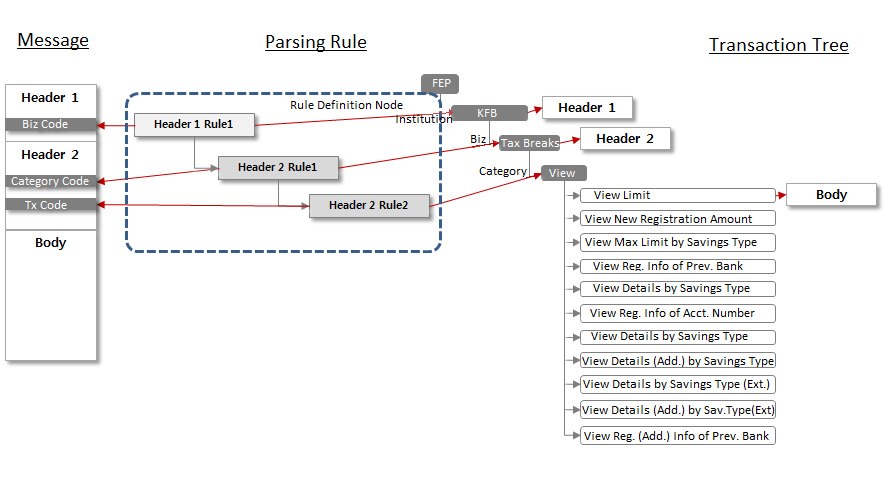 Transaction Tree and Message Parsing
Transaction Tree and Message ParsingThe basic purpose of a transaction tree is to find a transaction that matches the information of a message by parsing a request message and to invoke a service (service flows, outbound rules, or multi-bound rules) of the AnyLink engine.
Transaction and transaction group information contain symbolic link information that is referenced by a transaction node or a transaction group node. A symbolic link links other transaction nodes that contain the resources referenced by the transaction node. Since basically only resources in a parent node can be referenced, a symbolic link is useful when sharing resources in transaction or transaction group nodes other than the parent node.
Among the resources that are managed together in AnyLink transactions or transaction group nodes, there are various resources that are converted to Java code. For example, messages, mappings, expressions, and various user classes are resources that can be used in Java code.
Java code is read through a class loader, and each AnyLink transaction tree is designed to have parent and child relationships in the class loader.
A symbolic link node is not a parent on a class loader, but the node can be used as if it were a parent thanks to the AnyLink ClassLoader implementation.
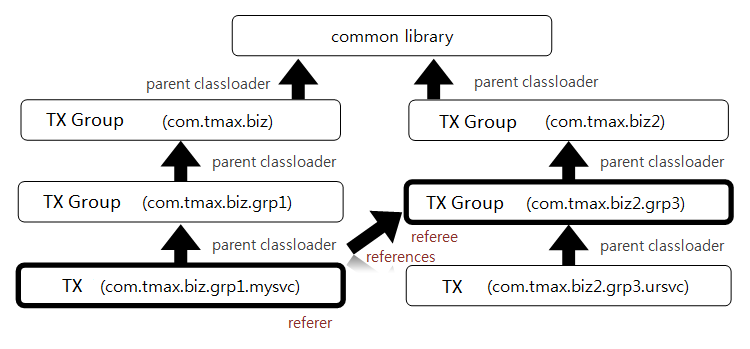 Symbolic Links and Java Class References
Symbolic Links and Java Class References -
Service Flow Definition File (XML Document Files with the .sfdl Extension)
A service flow definition file is drawn by using a BPMN (Business Process Modelling Notation) diagram in AnyLink Studio’s service flow editor.
Service flows are managed in the service flow engine, and the message events that are received are registered as AnyLink’s internal services.
In the most basic form of AnyLink transactions, messages are typically received through an inbound adapter, and the messages are parsed through a transaction tree for identifying internal services. Typically, an internal service of AnyLink is a message event of a service flow, and it proceeds according to the flow defined in the service flow, and then calls the service activity of the service flow. Service activities drawn in a flow are mostly adapter outbound rule services.
The following describes the most basic form of an AnyLink transaction: an external system is called though an outbound rule service and a response is received. The response is then passed to the calling flow and the response message is sent to the adapter that sent the initial message.
-
Parsing Rule
Parsing rules, which are rules for parsing external messages, are not managed as separate resources but instead are defined in transactions and transaction groups.
-
Adapter Outbound Rule (XML document files with a .orule extension)
A document that defines outbound adapter rules used to send requests from AnyLink to other systems. The configuration information differs according to the protocol and implementation of each adapter. Basic configuration information consists of request messages, response messages, abnormal response messages, and adapter and endpoint IDs.
An outbound rule is one of AnyLink’s internal services. If an outbound rule service is called internally from another component, it identifies the adapter and endpoint that are set in the rule, and sends messages to an external system.
-
Multi-binding Rule (XML Document Files with the .mbind Extension)
If an internal service of AnyLink needs to be routed differently depending on the situation, multiple services can be grouped together as a single group. This type of service is a multi-binding router rule. The following can be configured: service splitting, round robin, weight-based or time-based round robin, service flow correlation, handlers, etc. Request, response, and abnormal response message mapping (message conversion) can also be specified.
-
Message (XML Document File with the .Umsg Extension)
Multiple messages can exist inside a .Umsg file. AnyLink distinguishes two different types of messages: DTO (Data Transfer Object) which expresses the internal structure of the data used for input and output, and messages in specific formats. A .Umsg file can contain a single DTO and messages in many different formats. The messages must have the same structure with the DTO. The supported message formats include XML, fixed length, delimiter, NameValue, and JSON.
AnyLink converts DTOs and messages into Java code and manages it. This is for optimizing performance and efficiency. This means that the .class files generated by compiling .Java source files that correspond to .Umsg documents are included in transaction resources.
-
Message Mapping (XML Document Files with the .Map Extension)
A message mapping document defines the rules for converting input messages to output messages. AnyLink specifies conversion rules in the form of connecting the fields of each input message and output message, and can use various expressions as mapping sources in addition to the input message.
To improve the execution speed of mapping that consists of a combination of input/output fields or expressions, AnyLink internally converts mapping to Java code and manages it. Hence, just like message files, the .class file generated by compiling .Java source file is included in the transaction resource.
-
Expression (XML Document Files with the .expr Extension)
AnyLink uses expressions to indicate a part of a message or express a function expression.
An AnyLink expression can express the structure of a message. For example, if a field named field 1 exists in msg1, it is represented by the expression "msg1.field1". In a service flow, the user can access a DataField variable which is declared in a flow. For example, to access a field named "name" of a variable named dataField1, the user uses the expression "$dataField1.name".
In an AnyLink expression, the user can use parentheses to represent groups, and call Java methods. For example, in the variable example above, if a field named "name" corresponds to the Java String class, the user can extract only the first two characters as follows.
"$dataField1.name.substring(0, 2)"
Optionally, the user can explicitly specify the Java type of the variable. For example, if a variable named dataField1 has a datatype of com.example.NamedPerson, the user can rewrite the above expression as follows.
"$dataField1<com.example.NamedPerson>.name.substring(0,2)"
AnyLink converts expressions to Java code by considering the execution speed. Incorrect expressions will cause errors when converting and compiling Java code during deployment in Studio. Same as message and mapping files, .class files generated by compiling .expr files are included in transaction resources.
In AnyLink, expressions are used in splitting condition statements of service flows, correlation calculations, and multi-binding router rules.
Expressions that can be used to represent the source information of a message mapping have a slightly special form in order to support mapping characteristics, such as creating an empty object if there is an object reference of an empty source, and supporting array type mapping.
2.2. Environment Configurations for Transactions and Transaction Groups
The following describes the environment configuration files of transactions and transaction groups.
-
Environment Configuration for Transactions and Transaction Groups (XML document files with the .bizcfg extension)
Environment configuration documents of transactions and transaction groups are not directly related to transaction information, but stores information related to the transaction environment.
Transactions and transaction group resources are managed in a single .iar file for each node, but the environment configuration document files of transaction nodes exist separately in a document format with the .bizcfg extension under the directory that indicates the transaction node or transaction group node.
The environment configuration document can set the transaction and outbound rule trace log levels. The user can also specify thread pools to be used in service flows of corresponding transaction nodes.
2.3. Java Class Loader and Transaction Tree Class Loading Method
Business resources that indicate transactions and transaction groups contain automatically created Java code such as messages, mappings, and expressions, in addition to Java code such as user classes and handlers.
As mentioned earlier in explaining the symbolic link, each Java code follows the code reference structure by class loader configuration according to the characteristics of Java. AnyLink is executed in the Java EE environment, so a basic class loader has the following structure.
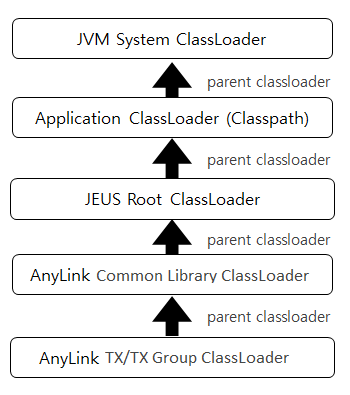
The AnyLink business ClassLoader is not a single ClassLoader, and has child ClassLoaders in a transaction tree format under the root ClassLoader.
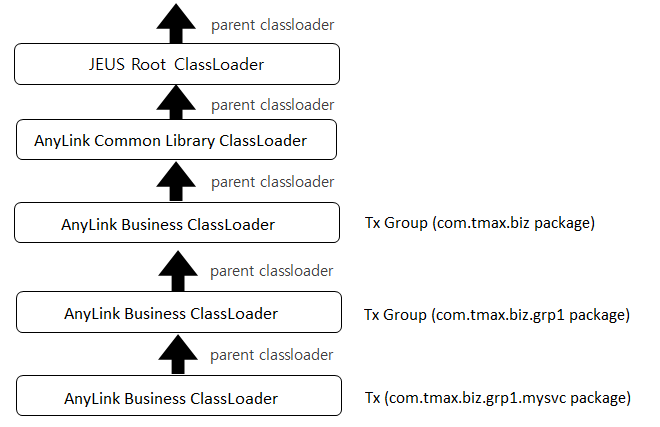
Due to the nature of the ClassLoader hierarchy, circular references across multiple layers are not allowed. This is also true when using symbolic links. Symbolic links create a type of parent ClassLoader-like relationship.
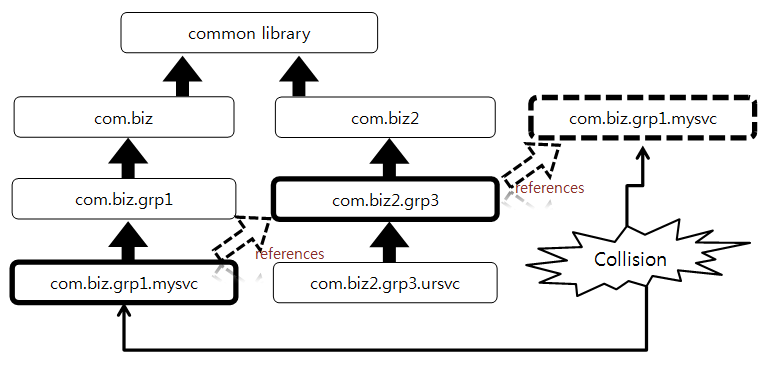
If a specific transaction or transaction group node’s information is modified and redeployed, then the node and all its child nodes are reloaded. The child nodes here contain logical child nodes that are referenced using a symbolic link.
3. Libraries
If there is a common Java library in an AnyLink transaction tree, then this library is managed in the library directory, separate from the transaction tree.
In the AnyLink business classloader hierarchy, a library is loaded by the top business classloader. When a library is deployed at the time of operation, due to the nature of loading the library code to the top level node of the classloader, the classloader of the entire transaction tree including the child nodes is loaded again.
By default, the library files are located under each server home directory on the runtime engine server.
${server.home}/repository/lib
4. Adapter Resources
The AnyLink runtime engine manages resources such as adapter communication endpoints and configuration information needed for adapters responsible for communication with various protocols and applications. Major adapter-related resources are adapter configuration information, endpoints, and endpoint groups.
By default, adapter resources are located under each server home directory on the runtime engine server.
${server.home}/repository/adapters
The following are the types of adapter resources.
-
Adapter
The adapter configuration information file is an XML document with the .adt extension, and sets information such as protocol, thread pool ID, trace log level, and clustering information.
AnyLink can set and generate trace logs and transaction logs by task. These logs are handled by the log adapter. For more information, refer to the adapter guide.
-
Endpoints and Endpoint Groups
An endpoint information file is an XML document with the .ep extension, and sets information such as communication direction, synchronization mode, transaction node ID, connection timeout, thread pool ID, trace log level, outbound endpoint log level, clustering information, and system error message.
An endpoint group groups together multiple endpoints, and is set in an XML document with the .epg extension. Set the method for splitting into child endpoints and endpoint groups. For example, routing methods such as round-robin, minimum-request, handler, and dedicated round-robin are supported. An endpoint group is represented by a parent directory with a child endpoint group or endpoint.
5. Configuring Business System Information
A business system is configured with a single runtime engine server or a runtime engine server cluster.
Servers included in a cluster of Java EE servers (which are the basis of AnyLink) belong to the same business system. In AnyLink, transaction tree information is shared within a business system. Therefore, the basic deployment unit of an application executed in AnyLink can be thought of as a business system unit. Hence, businesses such as transactions that are deployed differ according to the business system.
AnyLink runtime engine’s system settings are divided into common settings for business systems and settings for each individual runtime engine server. Mostly, thread pools, logging, Java EE server domain user ID, and password are set. If there are no special settings, then the default thread pool ID and service timeout are set. The user can set the basic trace log level of the system, as well as thread pool and queueing information in the file. The file also has various additional settings needed in the runtime engine server.
The section will describe the major configuration areas. For more information, refer to the description in the relevant section.
Business system configurations are saved in the following path for each server.
${server.home}/repository/bizsystem/bizsystem.config
<bizsystem.config>
<?xml version="1.0" encoding="UTF-8"?>
<ns0:bizSystemInfo xmlns:ns2="http://www.tmaxsoft.com/schemas/AnyLink/reliableQueue/"
xmlns:ns1="http://www.tmaxsoft.com/schemas/AnyLink/common/"
xmlns:ns3="http://www.tmaxsoft.com/schemas/AnyLink/serverPlugin/"
xmlns:ns0="http://www.tmaxsoft.com/schemas/AnyLink/">
<ns0:sysId>IFL_SYS</ns0:sysId>
<ns0:id>IFL_SYS</ns0:id>
<ns0:name>IFL_SYS</ns0:name>
<ns0:version>4</ns0:version>
<ns0:registererdDate>2014-10-13 12:54:03.514</ns0:registererdDate>
<ns0:registeringUser>admin</ns0:registeringUser>
<ns0:modificationDate>2014-11-10 20:20:09.829</ns0:modificationDate>
<ns0:user>administrator</ns0:user>
<ns0:passwd>ba05778dea933f47bc150c743b122336</ns0:passwd>
<ns0:bizSystemDefaultThreadPoolId>bizSystemDefaultThreadPool
</ns0:bizSystemDefaultThreadPoolId>
<ns0:threadPool>
<ns0:id>bizSystemDefaultThreadPool</ns0:id>
<ns0:name>bizSystemDefaultThreadPool</ns0:name>
<ns0:queueFullPolicy>SystemError</ns0:queueFullPolicy>
<ns0:useVipThread>false</ns0:useVipThread>
<ns0:threadPriority>-1</ns0:threadPriority>
<ns0:vipThreadPriority>-1</ns0:vipThreadPriority>
<ns0:commonSetting>
<ns0:queueSize>-1</ns0:queueSize>
<ns0:min>60</ns0:min>
<ns0:max>100</ns0:max>
<ns0:keepAliveTime>300</ns0:keepAliveTime>
<ns0:vipThreadCount>10</ns0:vipThreadCount>
</ns0:commonSetting>
</ns0:threadPool>
<ns0:systemLogging>
<ns0:fileLocation>${server.home}/logs/AnyLink_rte_%d{1}.log</ns0:fileLocation>
<ns0:logLevel>FINEST</ns0:logLevel>
<ns0:logger>
<ns0:name>com.tmax.anylink.dis.level</ns0:name>
<ns0:logLevel>INFO</ns0:logLevel>
</ns0:logger>
</ns0:systemLogging>
<ns0:nodeList>
<ns0:node>
<ns0:name>server1</ns0:name>
</ns0:node>
</ns0:nodeList>
<ns0:clusterGroup>
<ns0:adapterClusterGroup>
<ns0:adapterCluster>
<ns0:clusterId>TCP_ADT</ns0:clusterId>
<ns0:activeCount>2</ns0:activeCount>
<ns0:construction>
<ns0:serverId>server4</ns0:serverId>
<ns0:priority>0</ns0:priority>
<ns0:clusterMember>true</ns0:clusterMember>
</ns0:construction>
<ns0:construction>
<ns0:serverId>server5</ns0:serverId>
<ns0:priority>1</ns0:priority>
<ns0:clusterMember>true</ns0:clusterMember>
</ns0:construction>
<ns0:construction>
<ns0:serverId>server6</ns0:serverId>
<ns0:priority>2</ns0:priority>
<ns0:clusterMember>false</ns0:clusterMember>
</ns0:construction>
</ns0:adapterCluster>
</ns0:adapterClusterGroup>
</ns0:clusterGroup>
<ns0:deploymentPolicy>allowPartialDeploy</ns0:deploymentPolicy>
<ns0:encryptAlgorithm>AES128</ns0:encryptAlgorithm>
<ns0:debuggingMode>false</ns0:debuggingMode>
</ns0:bizSystemInfo>
5.1. Thread Pool
Set thread pools that can be used in the runtime engine. Detailed configurations for thread pools can be set commonly to all business systems or differently for each development runtime engine server.
The following shows a configuration example and a description of each item.
<ns0:threadPool>
<ns0:id>bizSystemDefaultThreadPool</ns0:id>
<ns0:name>bizSystemDefaultThreadPool</ns0:name>
<ns0:queueFullPolicy>SystemError</ns0:queueFullPolicy>
<ns0:useVipThread>false</ns0:useVipThread>
<ns0:threadPriority>-1</ns0:threadPriority>
<ns0:vipThreadPriority>-1</ns0:vipThreadPriority>
<ns0:commonSetting>
<ns0:queueSize>-1</ns0:queueSize>
<ns0:min>60</ns0:min>
<ns0:max>100</ns0:max>
<ns0:keepAliveTime>300</ns0:keepAliveTime>
<ns0:vipThreadCount>10</ns0:vipThreadCount>
</ns0:commonSetting>
</ns0:threadPool>
| Property | Description |
|---|---|
id |
Thread pool ID. |
name |
Thread pool name. |
queueFullPolicy |
Sets policies for full queues.
|
useVipThread |
Sets whether to use a specific number of VIP threads. |
threadPriority |
Sets the priority level of general threads. (Default value: 6) |
vipThreadPriority |
Sets the priority level of VIP threads. (Default value: 3) |
queueSize |
Sets the maximum size of job queues in thread pools. (Can be set for each server) |
max |
Maximum size of general thread pools. (Can be set for each server) |
min |
Minimum size of general thread pools. (Can be set for each server) |
keepAliveTime |
Default time for not cancelling an allocated thread. (Can be set for each server) |
vipThreadCount |
VIP thread count (fixed). (Can be set for each server) |
5.2. System Logging
Set system logging information in the business system configuration information. A System log is an internal log of the AnyLink runtime engine server.
The user can set the default log level and the log level for each logger. The log level for each logger can be specified differently for each server.
The following predefined variable values can be used for fileLocation, which indicates where the log file will be stored.
<ns0:systemLogging>
<ns0:fileLocation>${server.home}/logs/AnyLink_rte_%d{1}%h{1}%m{30}.log</ns0:fileLocation>
<ns0:logLevel>FINEST</ns0:logLevel>
<ns0:logger>
<ns0:name>com.tmax.anylink.serviceflow.level</ns0:name>
<ns0:logLevel>INFO</ns0:logLevel>
</ns0:logger>
<ns0:logger>
<ns0:name>com.tmax.anylink.runtime.level</ns0:name>
<ns0:logLevel>FINE</ns0:logLevel>
</ns0:logger>
</ns0:systemLogging>
| Property | Description |
|---|---|
server.home |
Location of the home directory for each server of the AnyLink runtime engine. |
domain.home |
Location of the home directory for each AnyLink domain. |
install.root |
Root directory location in which the AnyLink binary is installed. |
server.name |
Current AnyLink server name. |
adminServer.name |
Data integration server name of AnyLink. |
5.3. Cluster
Set cluster configuration for each adapter of business systems that uses clusters. All adapters are enabled if no configuration is set.
The following is a configuration example and description of each item.
<ns0:clusterGroup>
<ns0:adapterClusterGroup>
<ns0:adapterCluster>
<ns0:clusterId>TCP_ADT</ns0:clusterId>
<ns0:activeCount>2</ns0:activeCount>
<ns0:construction>
<ns0:serverId>server4</ns0:serverId>
<ns0:priority>0</ns0:priority>
<ns0:clusterMember>true</ns0:clusterMember>
</ns0:construction>
<ns0:construction>
<ns0:serverId>server5</ns0:serverId>
<ns0:priority>1</ns0:priority>
<ns0:clusterMember>true</ns0:clusterMember>
</ns0:construction>
<ns0:construction>
<ns0:serverId>server6</ns0:serverId>
<ns0:priority>2</ns0:priority>
<ns0:clusterMember>false</ns0:clusterMember>
</ns0:construction>
</ns0:adapterCluster>
</ns0:adapterClusterGroup>
</ns0:clusterGroup>
| Property | Description |
|---|---|
clusterId |
Cluster ID. |
activeCount |
Maximum number of active nodes. |
construction |
Sets the following for each server node.
|
5.4. Deployment Policy
By default, if a resource is not deployed to all servers, then the resource deployment will have failed. However, if some servers suffer from abnormal operation in a clustered environment, then deployment to just some servers can be performed.
The following shows a configuration example and a description of a property.
<ns0:deploymentPolicy>allowPartialDeploy</ns0:deploymentPolicy>
| Property | Description |
|---|---|
deploymentPolicy |
Sets the deployment policy.
|
5.5. Encryption Algorithm
Set the common encryption algorithm used in AnyLink.
The following shows a configuration example and a description of a property.
<ns0:encryptAlgorithm>AES128</ns0:encryptAlgorithm>
| Property | Description |
|---|---|
encryptAlgorithm |
Sets the encryption algorithm.
|
5.6. Debugging Mode
Set whether to allow flow debugging in the business system.
The following is a configuration example and a description of a property.
<ns0:debuggingMode>false</ns0:debuggingMode>
| Property | Description |
|---|---|
debuggingMode |
Sets the debugging mode.
|